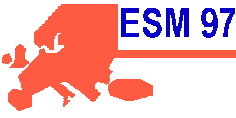
11th European Simulation Multiconference
Istanbul, Turkey, June 1-4, 1997
 |
FINAL PROGRAM 11th European Simulation Multiconference Istanbul, Turkey, June 1-4, 1997 |
| PLENARY ADRESSES |
| How Simulation Gains Acceptance as a Manufacturing Productivity Improvement Tool | |
| Tuesday 9:00-9:45 | Ball Room |
Edward J. Willliams
Post Office Box 470 Inkster,
Michigan 48141-0470, USA
day phone 313-594-6776
campus phone 313-593-5361
Abstract
Simulation is well-recognized among its expert practitioners as a manufacturing productivity improvement tool. Achievements of simulation in reducing operating costs, increasing production quotas, reducing work-in-process inventories, eliminating bottlenecks cost-effectively, achieving efficiency of scheduling procedures, and otherwise improving performance metrics are well-known among simulation experts and well-documented in the technical literature.
However, within many companies, simulation is used only in unusual situations and when the need for efficiency improvements has reached a high level of urgency and visibility among managers. This presentation describes procedures for upgrading the use of simulation to the status of "norm"; that is, making the exploitation of simulation's analytical powers a standard, expected step during the design, revision, or operation of a production system.
Specifically, the presentation will discuss:
- constructing a support infrastructure for simulation
- disseminating awareness of simulation and its benefits throughout an organization
- documentation of successful applications of simulation and the benefits
accruing from them
- organizing training classes and seminars in simulation
- evaluation, choice, and support of appropriate software tools
- evaluation and choice of simulation consultants and model builders
- maintaining knowledge of and enthusiasm for simulation within the organization.
In summary, the topics discussed in this presentation will guide managers and engineers in using simulation more frequently more effectively to prevent and resolve manufacturing productivity problems, thereby increasing corporate profitability.
Biography
Bachelors degree in mathematics, Michigan State University, 1967. Valedictorian. Earned 100% of college expenses via Alumni Distinguished Scholarship and part-time tutoring work.
Masters degree in mathematics, University of Wisconsin, 1968. Earned 100% of college expenses via National Science Foundation fellowship and part-time tutoring work.
1969-1971 United States Army (draftee). Statistical programming at Walter Reed Army Hospital, Washington, D.C. (after basic training), writing software to support biomedical research by Army doctors.
1972-present Ford Motor Company. Software developer and analyst; internal systems consultant in mathematical-modeling, operations-research, statistical, and discrete-process simulation software.
1978-1979 Plymouth Schools. Adult education instructor in contract and tournament bridge.
1980-1983 Wayne State University. Adjunct lecturer for undergraduate courses in FORTRAN, COBOL, algebra, calculus, and data structures, and for graduate course in software engineering.
1980-1983 Henry Ford Community College. Adjunct lecturer for undergraduate courses in COBOL.
1980-present University of Michigan - Dearborn. Adjunct lecturer for undergraduate courses in FORTRAN, PL/I, Pascal, C/C++, discrete mathematics, programming language design, data structures, operating systems, statistics, and process simulation. Adjunct lecturer for graduate courses in relational database design, compiler construction, software engineering, file and data structures, statistics, and process simulation.
| Effective Business Systems Engineering: The Contribution of Group Supported Dynamic Modelling | |
| Tuesday 9:45-10:30 | Ball Room |
Henk G. Sol
Delft University of Technology
School of Systems Engineering, Policy Analysis and Management
P.O. Box 5015, 2600 GA Delft, The Netherlands
phone: +31.15.278-4412
fax: +31.15.278-3429
e-mail: sol@sepa.tudelft.nl
Abstract
Dynamism is an inherent characteristic of the environment surrounding modern organizations. Consequently, organizations are forced to adapt their processes, structures, and technologies. The intrinsic character of these change efforts sets the requirements for involving groups of stakeholders and subject matter experts in change processes. Experiences show that both the quality and the productivity of participative change efforts can be enhanced by using electronic meeting and modelling support on the one hand, and simulation and animation techniques on the other hand. This presentation focuses on a business engineering approach that integrates GSS and simulation modelling into a support environment that allows for the participative modelling and design of organizational structures and processes. This approach has been successfully used in a substantial number of industry and governmental organizations.
| Modeling Failure Dependencies in Reliability Analysis Using Stochastic Petri Nets | |
| Wednesday 9:00-9:45 | Ball Room |
Ricardo M. Fricks and Kishor S.
Trivedi
Center for Advanced Computing and Communication
Department of Electrical and Computer Engineering
Duke University
Durham, NC 27708-0291, USA
Abstract
In this paper, we study the effect of failure dependencies in reliability models developed using stochastic Petri Nets and continuous time Markov chains. We also suggest a classification structure for the major causes of failure dependencies. Most of the identified categories are then illustrated through variations of a real time computer model. Of particular interest among the examples developed is the sample model that incorporates human errors. Although, human errors have received considerable attention over the past few decades, and significant Markov models have been proposed, to the best of our knowledge, no attempt has been made to explicitly incorporate human errors in stochastic Petri Net models. The advantage of expressing human errors using Petri Nets is then emphasized by the comparison of the Stochastic Petri Net model with the isomorphic Markov chain.
(c) SCS Europe, 1997. Authors: Ali Riza Kaylan, Alexander Verbraeck, SCS Europe Office. Last change: 03-02-03